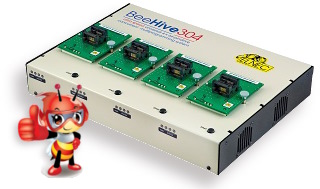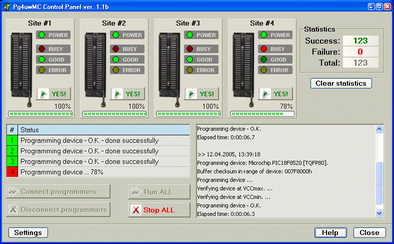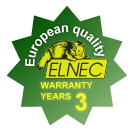BeeHive304 (obj. č. 60-0062)
Ultrarýchlostný univerzálny 4x 64-pinový produkčný multiprogramátor, dizajn bol zameraný na programovanie veľkokapacitných pamätí.

Cena: US $7300.00 [prečítaj toto!]
Je nám ľúto, ale vaše územie pokrýva náš výhradný distribútor. Kontaktujte prosím distribútor pre vašu krajinu – uvedené na našej webovej stránke.
Stručný popis:
- štyri nezávislé programovacie moduly založené na BeeProg3
- programátor sa dokonale vhodný preveľmi náročné desktopové programovanie, ako aj pre automatizované programovacie systémy
- založený na najmodernejšom dizajne FPGA, výkonnom procesore ARM a internom SSD, je BeeHive304 pripravený programovať zariadenia teoreticky možnými rýchlosťami
- 4 x 64-kolíkový bohatý na funkcie, presný a výkonný pindriver poskytuje programovacie signály pre každú technológiu programovateľných zariadení
- podporuje zariadenia s napätím VCC už 0,8 V
- ultra vysoká rýchlosť programovania, jeden z najrýchlejších programátorov na svete. Rýchlosť udržateľného programovania vyššia ako 31 MB za sekundu
- 8 GB eMMC NAND Flash je možné vykonať za menej ako 250 s, ak je podporovaná pamäť dostatočne rýchla
- využíva univerzálne programovacie moduly, určené pre typ balíka IC, aj špecializované moduly, navrhnuté optimalizované pre špecifické rodiny zariadení
- Ochrana ESD na každom pine rozhrania programovacích modulov (pindriver a tiež podporné signály)
- duálne pripojenie k počítaču: USB (2.0 HighSpeed) a LAN (až 1 Gbit)
- komfortný ovládací program, kompatibilný s Windows XP/2003/XPx64/Vista/Windows 7/Windows 8.1/Windows 10/Windows 11 (32-bit a 64-bit)
- dve jednotky BeeHive304 je možné pripojiť k jednému riadiacemu PC pre lepšie využitie programovacieho pracoviska
- implementácia do dostupných automatizovaných programátorov a ATE strojov tretích strán pomocou jednoduchého diaľkového ovládania
- jeden softvér dokáže obslúžiť až 64 programovacích miest v jednom automatickom programátore (16 programátorov BeeHive304)
- jedinečná rýchla reakcia na potreby zákazníka – aktualizácia softvéru môže byť pripravená do jedného dňa od vyžiadania, OnDemand softvér
- vyvinuté a vyrobené na Slovensku
- záruka - 3 roky
- certifikovaný CE skúšobňou, spĺňa požiadavky na CE certifikát

Voliteľné príslušenstvo:
Vlastnosti
Všeobecné
- BeeHive304 je ďalším členom série súbežných univerzálnych multiprogramátorov Elnec, ktorý bol skonštruovaný tak, aby uspokojil silný dopyt po extrémne rýchlom a spoľahlivom multiprogramátore pre vysokokapacitné pamäte .
- Tento programátor, navrhnutý s veľkým dôrazom na technickú dokonalosť a rýchlosť hardvéru, sa perfektne hodí pre veľmi náročné desktopové programovanie ako aj pre automatizované programovacie systémy a ATE strojoch, kde je zabezpečená najvyššia kvalita a celkový výnos.
- BeeHive304 pozostáva zo štyroch nezávislých izolovaných univerzálnych programovacích lokalít založených na hardvéri programovacieho jadra BeeProg3. Preto môžu programovacie miesta bežať asynchrónne (režim súčasného multiprogramovania). Každý programovací modul začne programovať v momente, keď sa zistí, že čip je správne vložený do pätice – nezávisle od stavu ostatných programovacích miest. Výsledkom je, že fungujú tri programovacie miesta, zatiaľ čo vy vymieňate naprogramovaný čip na štvrtom mieste.
- Multiprogramátor BeeHive304 podporuje toľko čipov ako BeeProg3programátor a bez zjavného zníženia rýchlosti programovania, pretože každý programovací modul funguje nezávisle. Taktiež každý programovací modul môže v prípade potreby naprogramovať iný čip.
- Jadro programátora BeeProg3 je založené na najmodernejšom FPGA, výkonnom procesore ARM a internom SSD, aby bolo pripravené na programovanie zariadení teoreticky možnými rýchlosťami. Dosiahnutá ultra rýchla programovacia rýchlosť – udržateľná viac ako 31 MB/s – je v skutočnosti vyššia, ako je možné využiť pre väčšinu skutočných zariadení. To sa odráža v extrémne krátkych časoch programovania. Napríklad 8 GB eMMC NAND Flash je možné vykonať za menej ako 250 sekúnd – ak to naprogramovaná pamäť umožňuje.
- Testy ukazujú, že BeeHive304 je momentálne rýchlejší ako všetci konkurenti v tejto cenovej kategórii (stav: 10/2015) a pre mnohé čipy je vôbec najrýchlejší.
- BeeHive304 podporuje všetky druhy typov a kremíkových technológií dnešných a budúcich programovateľných zariadení. Čiastočne podporuje aj zariadenia 'od včera'. Môžete si byť istí, že ďalšia podpora zariadení bude vyžadovať iba aktualizáciu softvéru, maximálne (ak je to potrebné) jednoduchý programovací modul, čím sa minimalizujú náklady na vlastníctvo.
- Pre správne a spoľahlivé programovanie ultra rýchlych pamätí využíva BeeHive304 špecializované moduly, optimálne navrhnuté pre konkrétne rodiny zariadení, presne podľa potrieb naprogramovaných zariadení. Ale ak je to možné, potom sa používajú univerzálne programovacie moduly určené pre typ obalu IC. Programovacie moduly sú identické pre všetkých programátorov založených na programovacom jadre BeeProg3.
- Konštrukcia programovacích modulov je navrhnutá pre dokonalú stabilitu v hornej časti programátora, aby bola dostatočne pevná na vkladanie/výmenu čipov mechanickým ramenom a zároveň umožňuje zachovať rovnakú polohu ZIF pätice aj po výmene modulu .
- Modulárna konštrukcia hardvéru - programovacie miesta fungujú samostatne - umožňuje nepretržitú prevádzku, keď sa časť programovacích miest stane nefunkčnou. Vďaka tomu je servis rýchly a jednoduchý.
- Snímacie obvody detegujú správne umiestnenie obvodu v pätici programovacieho modulu, čo umožňuje začať programovanie ihneď po vložení čipu. Operátor iba odoberie hotový čip a vloží nový čip. Školenie operátorov je preto minimalizované.
- BeeHive304 sa pripája k akýmkoľvek osobným počítačom kompatibilným s IBM PC s operačným systémom MS Windows cez USB (2.0 HigSpeed) port alebo LAN port (100 Mb).
- Zdierka pre pripojenie antistatického náramku umožňuje ľahkú implementáciu ESD ochrany.
- So svojou veľmi konkurencieschopnou cenou spolu s vynikajúcim hardvérovým dizajnom pre spoľahlivé programovanie je pravdepodobne najlepším programátorom "za dobrú cenu"v tejto triede.
Hardvér (platí pre každú programovaciu stránku)
- 64-kolíkový bohatý na funkcie, presný a výkonný pindriver BeeProg3 dodáva vysokorýchlostné, presné a čisté signály tvaru vlny do zariadenia elimináciou šumu, odrazov od zeme a prekmitov, čo maximalizuje výťažnosť programovania a zaručuje dlhé dáta. zadržiavanie. To tiež umožňuje spoľahlivú podporu prakticky akejkoľvek energeticky nezávislej technológie používanej pre programovateľné zariadenia - (E)EPROM, Flash, MRAM, PCM, ... - jediným programátorom zariadenia.
- Úplne rekonfigurovateľné pindrivery TTL založené na FPGA poskytujú H/L/pull_up/pull_down a čítanie pre každý pin zariadenia. Duálne H/L drivery umožňujú poskytnúť dve rôzne H úrovne pre jadrové signály aj I/O signály programovaného obvodu bez dodatočnej logiky. Programátor pindriver pracuje až do 0,8 V, preto je programátor pripravený na programovanie celej škály dnešných a budúcich pokročilých zariadení s veľmi nízkym napätím.
- Extrémne rýchle programovanie, dosiahnuté pomocou stavového stroja na báze FPGA, rýchleho procesora a SSD, umožňuje vykonávať všetky časovo kritické rutiny a prenosy dát vo vnútri programátora.
- Programátor vykoná test vloženia obvodu na základe kontroly správnej signálovej cesty medzi programátorom a naprogramovaným obvodom pred naprogramovaním každého obvodu. V závislosti od konfigurácie programovania identifikuje zmeškaný alebo zlý kontakt medzi programovaným obvodom a ZIF päticou programovacieho modulu, zmeškaný alebo zlý kontakt medzi programovacím modulom a programátorom a taktiež dokáže indikovať nesprávnu polohu obvodu v ZIF pätici alebo programovací modul (posunutý, otočený, orientovaný dozadu). Tieto funkcie podporované nadprúdovou ochranou a kontrolou bajtov podpisu pomáhajú predchádzať poškodeniu čipu v dôsledku chyby operátora.
- Schopnosť autotestu umožňuje spustiť diagnostickú časť softvéru na dôkladnú kontrolu zdravia programátora.
- Zabudované ochranné obvody eliminujú poškodenie programátora a/alebo programovaného obvodu vplyvom prostredia alebo zlyhania obsluhy. Všetky vstupy programátora BeeProg3, vrátane signálov pindriver, pripojenia k PC a vstupu napájania, sú chránené proti ESD do 15kV.
- Programovacie moduly sú dostupné pre zariadenia v PDIP, PLCC, JLCC, SOIC, SDIP, SOP, PSOP, SSOP, TSOP, TSOPII, TSSOP, QFP, PQFP, TQFP, VQFP, QFN (MLF), SON, BGA, EBGA, FBGA, VFBGA, UBGA, FTBGA, LAP, CSP, SCSP, LQFP, MQFP, HVQFN, QLP, QIP a ďalšie balíky.
Softvér (softvér na riadenie výrobného režimu: PG4UWMC)
- Táto časť softvéru je zameraná na jednoduché sledovanie veľkoobjemových výrobných operácií.
- Užívateľsky prívetivý ovládací softvér kombinuje mnoho výkonných funkcií s jednoduchým používaním. Grafické užívateľské rozhranie poskytuje prehľad o všetkých dôležitých výsledkoch činností bez zaťaženia obsluhy nepodstatnými detailmi.

- Na ovládanie multiprogramovacieho systému BeeHive304 sa používa projektový súbor. Projektový súbor obsahuje používateľské údaje, informácie o nastavení programovania čipu, konfiguračné údaje čipu, sekvenciu príkazov automatického programovania atď. Preto je chyba operátora minimalizovaná, pretože súbor projektu je normálne vytvorený a overený inžinierskymi a následne danými operátorovi. Pre súbor projektu je možné nastaviť voliteľný chránený režim, aby sa predišlo nechceným zmenám v súbore projektu.
- Každý čip môže byť naprogramovaný s rôznymi údajmi, ako je sériové číslo, informácie o konfigurácii a kalibrácii pomocou systému serializácie s bohatými funkciami.
Softvér (ovládač programovacích miest, riadiaci SW inžinierskeho režimu: PG4UW)
- Táto časť softvéru je zameraná na rýchlu a jednoduchú prípravu projektového súboru pre použitie v softvéri riadenia výrobného režimu.
- Programátor je poháňaný pohodlným a ľahko použiteľným ovládacím programom s rozbaľovacím menu, klávesovými skratkami a on-line nápovedou. Ide o rovnaký rokmi overený softvér, aký sa používa u všetkých ostatných programátorov Elnec.
- Výber zariadenia sa vykonáva podľa jeho triedy, podľa výrobcu alebo jednoducho napísaním fragmentu názvu dodávateľa a/alebo čísla dielu. Štandardné príkazy súvisiace so zariadením (čítanie, kontrola vymazania, programovanie, overenie, vymazanie) sú posilnené niektorými testovacími funkciami (test vloženia, kontrola bajtov podpisu) a niektorými < strong>špeciálne funkcie(autoinkrementácia, produkčný režim - spustenie programovania ihneď po vložení čipu do pätice).


- Ovládací program podporuje všetky známe formáty súborov. Čítacia funkcia automaticky rozpoznáva formát načítavaného súboru a urobí potrebnú konverziu dát.
- Softvér tiež poskytuje – v časti Informácie o zariadení – množstvo informácií o naprogramovanom obvode. Špeciálne sú k dispozícii nákresy všetkých dostupných balíkov. Softvér tiež poskytuje vysvetlenie označovania čipov (význam prefixov a prípon na čipoch) pre každý podporovaný čip.
- Bohaté funkcie serializačnej funkcie umožňuje priradiť jednotlivé sériové čísla každému naprogramovanému obvodu - alebo jednoducho zvýšiť sériové číslo, alebo funkcia umožňuje prečítať sériové čísla alebo akékoľvek identifikačné podpisy naprogramovaného zariadenia zo súboru a naprogramujte ho na naprogramované zariadenie.
- Súbory jam štandardu JEDEC JESD-71 interpretuje Jam Player. Jam súbory sú generované návrhovým softvérom, ktorý poskytuje výrobca príslušného programovateľného zariadenia. Čipy sa programujú cez rozhranie JTAG (IEEE 1149.1 Joint Test Action Group).
- Súbory VME interpretuje prehrávač VME Player. Súbor VME je komprimovaná binárna variácia súboru SVF a obsahuje operácie zbernice IEEE 1149.1 na vysokej úrovni. SVF súbory interpretuje SVF Player. Súbor SVF (Serial Vector Format) obsahuje operácie zbernice IEEE 1149.1 na vysokej úrovni. Súbory SVF sú generované návrhovým softvérom, ktorý poskytuje výrobca príslušného programovateľného zariadenia. Čipy sa programujú cez rozhranie JTAG. Súbory VME sú generované návrhovým softvérom, ktorý poskytuje výrobca príslušného programovateľného zariadenia.
Implementácia do automatizovaných programovacích systémov
- Programátor BeeHive304 je pripravený na použitie v automatizovaných programovacích systémoch, ako aj na testovanie ATE strojov mimo dosky. Rozmery programátora sú redukované na technické minimum pre tieto vlastnosti a kvalitný hardvér s cieľom minimalizovať réžiu pohybu ramena psovoda. Konštrukcia je mechanicky stabilná, aby bola odolná voči vibráciám počas prevádzky. Puzdro BeeHive304 je pripravené na pripevnenie zhora alebo zospodu tela programátora do automatického pracovného miesta programátora.
- BeeHive304 je možné implementovať do automatizovaného programátora (napríklad ako náhrada zastaraného programátora) alebo do nejakého handlera viacerými spôsobmi:
- 1) ak stačí jeden alebo dva programátory BeeHive304 na vykonanie všetkých úloh, potom stačí použiť jeden riadiaci PC pre celý programovací systém, ako pre riadenie stroja, tak aj pre softvér programátora. BeeHive304 je možné pripojiť k tomuto počítaču pomocou USB alebo LAN portu.
- 2) ak je potrebné implementovať do automatického programátora viac ako dva programátory BeeHive304, je potrebné použiť viac počítačov. Celý systém je škálovateľný až na 64 programovacích miest v jednom automatizovanom programovacom systéme znásobením programátorov BeeHive304 a riadiacich PC. Maximálna konfigurácia obsahuje 16 programátorov BeeHive304. Jeden riadiaci počítač v systéme slúži ako hlavná jednotka. Tu beží aj multiprogramovací riadiaci softvér, serializačný engine a rozhranie k hostiteľskému systému. Rozhranie riadiacich PC v celej sieti prebieha cez štandardnú LAN.
- Implementácia BeeHive304 do softvéru automatizovaných programátorov a handlerov je pomocou jednoduchého diaľkového ovládania ovládacieho softvéru PG4UWMC. Existujú príklady implementácie pre štandardné programovacie jazyky a samozrejme sme pripravení zákazníkovi s touto úlohou pomôcť.
Starostlivosť o zákazníkov
- Podpora na nové obvody (Služby AlgOR)
- Je dôležité si uvedomiť, že podpora väčšiny nových zariadení vyžaduje iba aktualizáciu softvéru, pretože BeeHive304 je skutočne univerzálny programátor. Vďaka našej rýchlej službe môže byť podpora pre nové zariadenie pridaná do niekoľkých hodín! Podrobnosti nájdete v službe AlgOR (Algorithm On Request) a softvéri OnDemand.
- Táto služba je poskytovaná takmer vo všetkých prípadoch zdarma. Akokoľvek, vyhradzujeme si právo požiadať zákazníka o spoluúčasť na vývojových nákladoch v prípade, že tieto náklady vyhodnotíme ako príliš vysoké.
- Bezplatná aktualizácia programového vybavenia
- Najnovšia verzia programového vybavenia je bezplatne k dispozícii na našej WEB stránke v časti na tejto stránke
- Bezplatná Technická podpora
- Technická podpora Elnec (dostupná prostredníctvom formulára/e-mailu) Vám zaručuje reakciu na Vaše žiadosti najneskôr nasledujúci pracovný deň (zvyčajne v priebehu niekoľkých hodín).
- Služba Keep-Current
- V rámci služby Keep Current je zasielaná zákazníkom najnovšia verzia ovládacieho programu a doplnky k návodu na obsluhu a použitie (Keep-Current balíček). Služba Keep-Current zaručuje jednoducho a bez zmätkov aktuálne najvyššiu kvalitu programovania na programátoroch Elnec.
- Rýchle doručenie zásielok
- Kombinácia rozsiahlych zásob výrovkov, flexibilnej výroby a využívania služieb svetoznámych prepravných spoločností, zaručuje zákazníkovi rýchlu dodávku objednaného tovaru. Produkty objednané pred 10:00 budú odoslané v rovnaký pracovný deň (za predpokladu, že objednané produkty sú na sklade a platba za tovar je pripísaná na náš účet).
- Záruka

- Elnec poskytuje bezplatnú prepravu produktu opraveného v rámci záruky späť k zákazníkovi. Záruka je platná od dátumu zakúpenia produktu.
- Preferenčné vybavenie potencionálnych požiadaviek na opravu výrobku zaručuje úspešná registrácia produktu, ktorá by mala byť vykonaná do 60 dní od zakúpenia na tejto stránke: Registrácia produktu.
Špecifikácia (multiprogramovací systém BeeHive304)
- 4x univerzálny programovací modul (4x programovacie jadro BeeProg3)
- prevádzková LED, LED zapnuté
- port USB 2.0 high-speed kompatibilný, prenosová rýchlosť do 480 Mbit/s, pripojený k internému rozbočovaču USB
- 1 Gbit LAN port, pripojený k internému LAN switchu
- príkon linky 100-240VAC/90W max (pri použití externého zdroja).
- ochrana proti prepätiu a ESD na všetkých vstupoch (napájanie, komunikácia, rozhranie programovacieho modulu)
- zdierka pre pripojenie antistatického náramku
- zdierka pre pripojenie k uzemňovacej časti
Špecifikácia (platí pre každé programovací modul)
HARDVÉR
Programátor, prevodníky
- port USB 2.0 high-speed kompatibilný, prenosová rýchlosť do 480 Mbit/s
- 100Mbit LAN port
- zabudovaná inteligencia: výkonný procesor (ARM9 400 MHz) a stavový stroj na báze FPGA (základný takt 50 MHz plus PLL)
- vstavaný mSATA SSD ako interná vyrovnávacia pamäť (typ 128 GB, možnosť rozšírenia na vyššiu kapacitu) (*1, *2, *3, *4)
- tri D/A prevodníky pre VCC1, VCC2 a VPP, regulovateľný čas nábehu a poklesu
- VCC1, VCC2 rozsah 0,8V...7V/1A (krok 10mV)
- Rozsah VPP 0V..25V/1A (krok 25mV)
- Teplotne riadené ventilátory
- schopnosť selftestu
- ochrana proti prepätiu a ESD na vstupe zdroja, USB a LAN porte a všetkých pinoch rozhrania programovacieho modulu (PMI) (IEC1000-4-2: 15kV vzduch, 8kV kontakt)
- zdierka pre pripojenie antistatického náramku
- skrutka s dvoma podložkami na spojenie s uzemňovacou časťou
Poznámky:
- *1: dáta vo vyrovnávacej pamäti sú uložené vo fragmentoch a tiež čiastočne komprimované, preto môže vyrovnávacia pamäť uchovávať štandardné dáta aj pre zariadenia s väčšími rozmermi, ako je aktuálna veľkosť vyrovnávacej pamäte
- *2: tento upgrade je mechanicky komplikovaný a dá sa vykonať len v Elnecu
- *3: programátory od s/n 3004-00041 (vrátane) boli dodávané s 32GB SSD ako internou vyrovnávacou pamäťou.
- *4: 128 GB SSD dokáže uložiť ako vyrovnávaciu pamäť približne 110 GB náhodných údajov (28 GB v prípade 32 GB SSD), väčšie veľkosti SSD, proporcionálne. Ak plánujete pracovať/kopírovať eMMC/NAND zariadenie, ktoré môže obsahovať náhodné dáta v celom rozsahu veľkosti zariadenia, odporúčame mať v programátore rovnakú kapacitu vyrovnávacej pamäte.
Pindriver (dostupný na Programming Module Interface (PMI) - konektory pre programovacie moduly)
- pindrivery: 64 univerzálnych
- Ku každému kolíku je možné pripojiť VCC1/VCC2 a VPP
- kvalitné pripojenie GND pre každý pin
- 2 nezávislé TTL drivery na báze FPGA poskytujú H, L, CLK, pull-up, pull-down na všetkých pindriver pinoch, logická úroveň 0,75V - 5V (IOL a IOH prúd 20mA)
- frekvencia logických signálov: až 125 MHz (3,3 V), 80 MHz (5 V)
- analógový pindriver výstupná úroveň voliteľná od 0,8 V do 25V
- prúdové obmedzenie, vypnutie pri prekročení prúdu a výpadku napájacieho napätia
- test vodivosti programátora: všetky piny sú testované pred každou programovacou procedúrou
Softvér
- Algoritmy: použité sú výhradne výrobcom obvodov schválené, alebo odporúčané algoritmy. Doplnenie špeciálneho algoritmu podľa požiadaviek za príplatok.
- Nové verzie SW: nové verzie programového vybavenia sú k dispozícii približne každé 4 týždne, bezplatne. OnDemand verziu programu poskytujeme pre doplnenie podpory aktuálnych obvodov a opravu chýb. Môže byť aktualizovaná denne.
- Základné vlastnosti: história revízií, protokol práce, on-line nápoveda, informácie o obvodoch a algoritmoch.
Operácie s obvodom
- štandardné:
- inteligentný výber obvodu podľa typu, výrobcu alebo časti mena obvodu
- kontrola vymazania, čítanie, verifikácia
- programovanie
- výmaz
- konfiguračný a bezpečnostný program
- kontrolná suma
- interpretuje Jam Standard Test and Programming Language (STAPL), JEDEC standard JESD-71
- interpretuje VME/SVF súbory
- interpretuje SVF súbory (Serial Vector Format)
- interpretuje Actel STAPL Player súbory
- zabezpečovacie:
- kontrola správneho vloženia
- kontrola kontaktu ZIF-obvod
- kontrola identifikačných (ID) byte obvodu
- špeciálne:
- výrobný mód (automatický štart programovania po vložení obvodu)
- multi-project mód
- niekoľko serializačných módov (viac typov inkrementálnych módov, from-file mód, custom generator mód)
- štatistika
- count-down mód
Operácie s buffrom
- view/edit, find/replace
- fill/copy, move, byte swap, word/dword split
- checksum (byte, word)
Akceptované formáty súborov
- automatická identifikácia typu súboru
Akceptované formáty súborov- neformátovaný (raw) binárny
- HEX: Intel, Intel EXT, Motorola S-record, MOS, Exormax, Tektronix, ASCII-SPACE-HEX,, ASCII HEX, Renesas Consolidated HEX
- Altera POF, JEDEC (ver. 3.0.A), napr. od ABEL, CUPL, PALASM, TANGO PLD, OrCAD PLD, PLD Designer ISDATA, atď.
- JAM (JEDEC STAPL Format), JBC (Jam STAPL Byte Code), STAPL (STAPL File) JEDEC standard JESD-71
- VME (ispVME súbor VME2.0/VME3.0)
- SVF (Serial Vector Format revision E)
- STP (Actel STAPL file)
Programované obvody
Programátor pomocou programovacích modulov:
- NAND FLASH: 3D-Plus 3DFNxxx, All-Flash AFAxxx, ATO Solution AFNDxxx, Axia Memory Tech. AX20xxx, Cypress (ex Spansion) S30Mxxx, S34xxx, Eon Silicon Sol. EN27xxx, EN71xxx, ESIGMA ES27xxx, ESMT F59xxx, FM6xxx, Dosilicon FMNxxx, FMNDxxx, Fidelix FMNxxx, FMNDxxx, Flexxon FHNDxxx, FORESEE FS33xxx, Fudan FM29xxx, GigaDevice GD9Fxxx, MD5Nxxx, HeYangTek HYNxxx, ICMAX IMSxxx, ISSI IS34xxx, Jeju Semiconductor JS27Hxxx, Macronix MX30xxx, MX63xxx, Micron MT29Fxxx, MT29Cxxx, MT29Rxxx (exNumonyx ex STM) NANDxxx, MIRA PSUxxx, PowerFlash ASUxxx, A1Uxxx, Samsung K9xxx, KFxxx, SK Hynix (ex Hynix) HY27xxx, H27xxx, Toshiba TC58xxx, TH58xxx, UnilC SCNxxx, Winbond W29Nxxx, W71Nxxx, XTX (ex Paragon) PN61xxx, Zentel A5Uxxx, Zetta ZDNDxxx, LBA-NAND Toshiba THGVNxxx rodina
- eMMC: Hynix H26Mxxxxxxxx, Kingston KE44B-xxxx/xxx, Micron MTFCxxxxxx, Numonyx NANDxxxxxxxx, Phison PSM4A11-xx, Samsung KLMxxxxxxx, SanDisk SDINxxx-xx, Toshiba THGBMxxxxxxxxxx, Flexxon FEMCxxxGTTG, ISSI, IS21ESxxG, Greenliant GLS85VMxxxxx rodina
- eMCP: Micron MT29xZZZxxxxxxxx rodina
- eSD: XTX Technology XTSDxxGLGxxx, All-Flash SDVxxxMxxxxx rodina
- EPROM: NMOS/CMOS, 27xxx and 27Cxxx rodina
- Memory Cards: MMC, SD, SDHC, SDXC rodina
- Multi-chip devices: NAND+RAM, NOR+RAM, NOR+NOR+RAM, NAND+NOR+RAM
- Sériové Flash: standard SPI, Multi I/O - Dual I/O, Quad I/O, Dual-Quad I/O, Octa I/O (25Bxxx, 25Dxxx, 25Exxx, 25Fxxx, 25Hxxx, 25Lxxx, 25Mxxx, 25Pxxx, 25Qxxx, 25Rxxx, 25Sxxx, 25Txxx, 25Uxxx, 25Vxxx, 25Wxxx, 25Xxxx, 26Vxxx, 45PExx, MX66Lxxx, S70FLxxx, S79FL, MT35X rodina), DataFlash (AT45Dxxx, AT26Dxxx rodina)
- parallel NOR Flash: 28Fxxx, 29Cxxx, 29Fxxx, 29GLxxx, 29BVxxx, 29LVxxx, 29Wxxx, 39VFxxx, 39SFxxx, 49Fxxx rodina, Samsung's K8Fxxxx, K8Cxxxx, K8Sxxxx, K8Pxxxx rodina, ...
- HyperFlash: Cypress/Spansion/ISSI S26KL, S26KS rodina
- Sériové E(E)PROM: Sériové E(E)PROM: 11LCxxx, 24Cxxx, 24Fxxx, 25Cxxx, 30TSExxx, 34Cxxx, 34TSxx, 59Cxxx, 85xxx, 93Cxxx, NVM3060, MDAxxx rodina, full support for LV rodina, AT88SCxxx
- Sériové FRAM: Cypress(Ramtron): FM24xxxxxx, FM25xxxxxx, Fujitsu: MB85RCxxxx, MB85RSxxxx, Lapis(OKI, Rohm): MR44xxxxx, MR45xxxxx rodina
- Sériové MRAM: Everspin MR20xxx, MR25xxx rodina
- Konfiguračné (EE)PROM: XCFxxx, XC17xxxx, XC18Vxxx, EPCxxx, EPCSxxx, EPCQxxx, EPCQLxxx, EPCQxxxA, AT17xxx, AT18Fxxx, 37LVxx rodina
- PLD Altera: MAX 3000A, MAX 7000A, MAX 7000B, MAX 7000S, MAX7000AE, MAXII/G/Z, MAX V, MAX 10 rodina
- PLD Intel: MAX II/G/Z, MAX V, MAX 10 rodina
- PLD Lattice: ispGAL22V10x, ispLSI1xxx, ispLSI1xxxEA, ispLSI2xxx, ispLSI2xxxA, ispLSI2xxxE, ispLSI2xxxV, ispLSI2xxxVE, ispLSI2xxxVL, LC4xxxB/C/V/ZC/ZE, M4-xx/xx, M4A3-xx/xx, M4A5-xx/xx, M4LV-xx/xx, ispCLOCK, Power Manager/II, ProcessorPM, CrossLink, Platform Manager/2, L-ASC10 rodina
- PLD Xilinx: XC9500, XC9500XL, XC9500XV, CoolRunner XPLA3, CoolRunner-II rodina
- SPLD/CPLD rodina: AMD, AMI, Atmel, Cypress, Gould, ICT, Lattice, National Semicond., Philips, STMicroelectronics, TI (TMS), Vantis, VLSI
- FPGA: Lattice: MachXO, MachXO2, MachXO3, LatticeXP, LatticeXP2, ispXPGA, iCE40 UltraPlus, iCE40 Ultra/UltraLite, iCE40 LP/HX, non-volatile key: ECP2 S-Series
- FPGA: Microsemi(Actel): ProASIC3, IGLOO, Fusion, ProASICplus, SmartFusion
- FPGA: Intel/Altera, non-volatile key: Cyclone V
- FPGA: Xilinx: Spartan-3AN
- Špeciálne obvody: STM LED Array Drivers ALED1262xxx rodina
- Mikroprocesory Analog Devices: ADuC8xx rodina
- Mikroprocesory Abov Semiconductor: GMS97Cxxx, GMS97Lxxx, GMS99Cxxx rodina
- Mikroprocesory Atmel AVR 8bit/16bit: AT90Sxxxx, AT90pwm, AT90can, AT90usb, ATtiny, ATmega, ATxmega rodina
- Mikroprocesory Atmel AVR32: AT32UC3xxxx, ATUCxxxD3/D4/L3U/L4U rodina
- Mikroprocesory Atmel/Microchip/Temic MCS51 rodina: AT(T)89C/F/S/LS/LV/LP rodina
- Mikroprocesory Atmel/Microchip ARM AT91SAM7Sxx, AT91SAM7Lxx, AT91SAM7Xxx, AT91SAM7XCxx, AT91SAM7SExx rodina
- Mikroprocesory Atmel/Microchip ARM9: AT91SAM9xxx rodina;
- Mikroprocesory Atmel/Microchip ARM Cortex-M0+: ATSAMD2x, ATSAMC2x, ATSAMD09x, ATSAMD10x, ALSAML2x, ATSAMHAx, ATSAMR2x rodina
- Mikroprocesory Atmel/Microchip ARM Cortex-M3: ATSAM3Axxx, ATSAM3Uxxx, ATSAM3Nxxx, ATSAM3Sxxx, ATSAM3Xxxx rodina
- Mikroprocesory Atmel/Microchip ARM Cortex-M4: ATSAM4Sxxx, ATSAMG5x, ATSAM4LCx, ATSAM4LSx rodina
- Mikroprocesory Atmel/Microchip ARM Cortex-M4F: ATSAMD51x, ATSAME53x rodina
- Mikroprocesory Atmel/Microchip ARM Cortex-M23: ATSAML10x, ATSAML11x rodina
- Mikroprocesory Atmel/Microchip ARM Cortex-M7: ATSAME70x, ATSAMV70x, ATSAMV71x, ATSAMS70x rodina
- Mikroprocesory Azoteq: IQS5xx rodina
- Mikroprocesory Cypress: CY7Cxxxxx, CY8Cxxxxx rodina
- Mikroprocesory Cyrod Technologies MCS51: CRD89C/L/V rodina
- Mikroprocesory Energetic Technology: ET12xx, ET22xx, ET23xx rodina
- Mikroprocesory Explore Microelectronic: EPF01x, EPF02x rodina
- Mikroprocesory Freescale Semiconductor: S12X rodina
- Mikroprocesory Coreriver: Atom 1.0, MiDAS1.0, 1.1, 2.0, 2.1, 2.2, 3.0 rodina
- Mikroprocesory GigaDevice: GD32Exxx, GD32Fxxx rodina
- Mikroprocesory Hitachi: H8 rodina, H8S rodina, H8 Tiny rodina, SH rodina
- Mikroprocesory Infineon(Siemens): XC2000, XE164 rodina
- Mikroprocesory ICSI/ISSI MCS51: IS89C/E/LV rodina
- Mikroprocesory Lapis Semiconductor: ML620Qxxxx rodina
- Mikroprocesory Megawin: MG87xxx, MPC82xxx rodina
- Mikroprocesory Microchip PICmicro: PIC10xxx, PIC12xxx, PIC16xxx, PIC18xxx, PIC24xxx, dsPIC, PIC32xxx rodina
- Mikroprocesory Mitsubishi: M16C rodina
- Mikroprocesory Motorola/Freescale: S12, MCF52 (ColdFire), MC56F, Kinetis (K,L) rodina, Qorivva/5xxx Power Architecture
- Mikroprocesory NEC: uPD70Fxxx, uPD78Fxxx rodina
- Mikroprocesory Nordic Semiconductor: nRF24LExxx, nRF24LUxxx, nRF315xx, nRF51xxx, nRF52xxx Flash and OTP rodina
- Mikroprocesory Nuvoton ARM Cortex-Mx: NUC1xx, NUC2xx, M05x, Mini51, Nano1xx rodina
- Mikroprocesory Nuvoton (Winbond) MCS51 rodina: N79xxx, W77xxx, W78xxx, W79xxx, W83xxx rodina
- Mikroprocesory NXP (Philips/Trident Microsystem) UOC rodina: UOCIII, UOC-TOP, UOC-Fighter (TDA1xxxx) rodina
- Mikroprocesory NXP (Philips) MCS51 rodina: 87Cxxx, 87LVxx, 89Cxxx, 89Sxxx, 89Fxxx, 89LVxxx, 89LSxxx, 89LPxxx, 89Exxx, 89Lxxx, LPC rodina
- Mikroprocesory NXP (Philips) ARM Cortex-Mx: LPC11xx, LPC11Cxx, LPC11Dxx, LPC11Uxx, LPC11Axx, LPC11Exx, LPC11xxLV, LPC12xx, LPC12Dxx, LPC13xx, LPC15xx, LPC17xx, LPC18xx, LPC40xx, LPC43xx, LPC8xx, EM7xx, MPT6xx, LPC541xx, LPC546xx, PN73xx, PN74xx rodina
- Mikroprocesory NXP (Philips) ARM7: LPC2xxx, MPT6xx rodina
- Mikroprocesory NXP (Motorola/Freescale Semiconductor): S12, S12X, Kinetis rodina
- Mikroprocesory Panasonic: MN101, MN103 rodina
- Mikroprocesory Princeton MCS51: PT89xx rodina
- Mikroprocesory Renesas: R8C/Tiny rodina, RX rodina, uPD70Fxxx, uPD78Fxxx rodina, RL78 rodina, R32C rodina, RH850 rodina, H8 rodina, H8S rodina, H8 Tiny rodina, SH rodina, M16C rodina
- Mikroprocesory Ramtron (Goal Semiconductor) MCS51 rodina: VRS5xx, VRS7xx, VRS9xx, VRS1xxx, VRS51C(L)xxx, VRS51C(L)7xx, VRS51C(L)9xx, VRS51C(L)1xxx rodina
- Mikroprocesory Silicon Laboratories(Cygnal): C8051 rodina
- Mikroprocesory Silicon Laboratories(Ember) ARM Cortex-Mx: EM34x, EM35x, EM358x, EM359x rodina
- Mikroprocesory Silicon Laboratories(Energy Micro): EFM32Gxx, EFM32GGxx, EFM32LGxx, EFM32TGxx, EFM32WGxx rodina
- Mikroprocesory Silicon Laboratories: SiM3Cxxx, SiM3Lxxx, SiM3Uxxx rodina
- Mikroprocesory Spansion(Fujitsu): MB90Fxxx, MB91Fxxx, MB95Fxxx, MB96Fxxx, MB9AFxxx, MB9BFxxx rodina
- Mikroprocesory STM (SGS-Thomson): SPC5 (Power Architecture), ST6xx, ST7xx, ST10xx, STR7xx, STR9xx, STM32F/G/H/L/W, STM8A/S/L/T rodina
- Mikroprocesory SyncMOS: SM39xxx, SM59xxx, SM73xxx, SM79xxx, SM89xxx rodina
- Mikroprocesory Syntek MCS51: STK6xxx rodina
- Mikroprocesory Tekmos MCS51: TK87Cxxx rodina
- Mikroprocesory Texas Instruments (Chipcon): CC11xx, CC24xx, CC25xx, CC85xx rodina
- Mikroprocesory Texas Instruments ARM Cortex-Mx: CC13xx, CC2538xxx, CC26xx rodina
- Mikroprocesory Texas Instruments (Luminary Micro): LM3Sxxx, LM3Sxxxx rodina, LM4Fxxxx rodina, TM4C rodina
- Mikroprocesory Texas Instruments: MSP430 rodina
- Mikroprocesory Texas Instruments: TMS320F rodina
- Mikroprocesory Toshiba: TX03 rodina
- Mikroprocesory Topro MCS51: TP28xx rodina
- Mikroprocesory Nuvoton (Winbond) MCS51 rodina: N76xxx, N79xxx, W77xxx, W78xxx, W79xxx rodina
- Mikroprocesory Nuvoton ARM Cortex-Mx: NUC029xxx, NUC1xx, NUC2xx, M05x, MINI5x, NDA1xx, NANO1xx rodina
- Mikroprocesory ZILOG: Z8Fxxxx, Z8FMCxxxxx, Z16Fxxxx, ZGP323xxxxxx, ZLP12840xxxxx, ZLP323xxxxxxx, ZLF645xxxxxxx rodina
- .
- --- we're also working on the support of discontinued/obsolete/rare devices mentioned below this line ---
- .
- EEPROM: NMOS/CMOS, 28xxx, 28Cxxx, 27EExxx rodina, 3D Plus 3DEExxxxxxxx rodina
- FRAM: Ramtron
- MRAM: Everspin MRxxxxx8x, 3D Plus 3DMRxxxxxxxx rodina
- NV RAM: Dallas DSxxx, SGS/Inmos MKxxx, SIMTEK STKxxx, XICOR 2xxx, ZMD U63x rodina
- mDOC H3: SanDisk (ex M-Systems) SDED5xxx, SDED7xxx, MD2533xxx, MD2534xxx, Hynix HY23xxx rodina
- 1-Wire E(E)PROM: DS1xxx, DS2xxx rodina
- Clocks: TI(TMS), Cypress
- PLD Altera: Classic
- PLD AMD, TI(TMS): Bipolar families
- Špeciálne obvody: Atmel Tire Pressure Monitoring ATA6285N, ATA6286N; PWM controllers: Zilker Labs, Analog Devices; Multi-Phase ICs: IR(Chil Semiconductor); Gamma buffers: AUO, Maxim, TI, ...
- Mikroprocesory MCS51 rodina: 87Cxxx, 87LVxx all manufacturers
- Mikroprocesory ELAN: EM78Pxxx rodina
- Mikroprocesory EPSON: S1C17 rodina
- Mikroprocesory Generalplus: GPM8Fxxx rodina
- Mikroprocesory GreenPeak: GPxxx rodina
- Mikroprocesory Infineon(Siemens): XC800, C500, XC166, C166 rodina
- Mikroprocesory MDT 1xxx and 2xxx rodina
- Mikroprocesory Motorola/Freescale: HC05, HC08, HC11, HC12, HCS08, RS08, MCF51 rodina
- Mikroprocesory Myson MTV2xx, 3xx, 4xx, 5xx, CS89xx rodina
- Mikroprocesory National: COP8xxx rodina
- Mikroprocesory Novatek: NT68xxx rodina
- Mikroprocesory NXP (Philips) ARM7: PCD807xx, SAF7780xxx rodina
- Mikroprocesory NXP (Philips) ARM9: LPC31xx rodina
- Mikroprocesory Texas Instruments: MSC12xx rodina, CC430 rodina
- Mikroprocesory ZILOG: Z86/Z89xxx rodina
- Mikroprocesory other: EM Microelectronic, Hitachi, Holtek, Novatek, Macronix, Samsung, Toshiba, Mitsubishi, Realtek, M-Square, ASP, Coreriver, Gencore, EXODUS Microelectronic, TinyARM, VersaChips, SunplusIT, M-Square, QIXIN, Signetic, Tekmos, Weltrend, Amic, Ember, Samsung, ABOV Semiconductor...
Poznámky:
- aktuálny zoznam všetkých podporovaných obvodov.
Podporované puzdra
- podpora puzdrenia DIP, SDIP, PLCC, JLCC, SOIC, SOP, PSOP, SSOP, TSOP, TSOPII, TSSOP, QFP, PQFP, TQFP, VQFP, QFN (MLF), SON, BGA, EBGA, FBGA, VFBGA, UBGA, FTBGA, LAP, CSP, SCSP, LQFP, MQFP, HVQFN, QLP, QIP atď.
Rýchlosti programovania

Poznámky:
- Je dôležité povedať, že na testovanie rýchlosti programovania vždy používame dátový vzor náhodných čísel. Niektorí naši konkurenti používajú "riedky" dátový vzor, kde je naprogramované len malé množstvo neprázdnych dát alebo sú použité dáta len s niekoľkými 0 bitmi (FE, EF atď.). Tento podvádzací prístup môže značne „skrátiť“ čas programovania. Ak plánujete porovnávať, vždy sa opýtajte, ktorý vzor používajú.
- Rýchlosť programovania prakticky nezávisí od typu PC, pretože dáta pre programovanie a hlavná časť programovacieho algoritmu sú uložené interne vo vnútri programátora.
- Všetky nižšie uvedené zariadenia, vrátane oboch NAND Flash, sú naprogramované na maximálnu rýchlosť, čas programovania nemôže byť kratší.
- V súčasnosti nie je veľa zariadení, kde by sa dala využiť rýchlosť programovania BeeHive304 30+ MB/s.
| Obvod | Veľkosť [bity] | Operácie | Čas | |
|---|---|---|---|---|
| JS28F00AM29EWH (paralelný NOR Flash) | 4000080hx16 (1 Giga) | programovanie a verifikácia | 110 sek. | |
| MT29F1G08ABAEAWP (paralelný NAND Flash) | 8400000hx8 (1 Giga) | programovanie a verifikácia | 21.5 sek. | |
| SDIN8DE2-8G (eMMC NAND FLASH) | 1D2000000hx8 (64 Giga) | programovanie *1 | 269 sek. | |
| S25FL164K (serial Flash) | 800300hx8 (64 Mega) | programovanie a verifikácia | 21.5 sek. | |
| AT89LP51RD2 (mikroprocesor) | 10000hx8 | programovanie a verifikácia | 7.3 sek. | |
| PIC32MX360F512L (mikroprocesor) | 80000hx8 | programovanie a verifikácia | 9.3 sek. | |
| *1: Overenie naprogramovania sa vykonáva interným ovládačom zariadenia eMMC. Zariadenie dostane blok údajov plus CRC, ak sa všetky zhodujú, interný ovládač potvrdí správne naprogramovanie. Konfigurácia: Typ PC: Intel i3-4130, 3.4GHz, 4GB RAM, USB 2.0 HS, Windows 10 Pro, Verzia SW: 3.53, 10/2019. | ||||
Všeobecné
Dokumentácia
Systémové požiadavky
- Všeobecné požiadavky, dané ovládacím programom
- Požiadavky vyplývajúce z hardware programátora:
- jeden USB port 2.0 kompatibilný
- alebo jeden port LAN
Operácie
- externý napájací zdroj: prevádzkové napätie 100-240V AC menovité, 90-264 VAC max., 47 63Hz. Výstupné napätie: 15V, 6A, dĺžka výstupného kábla 120 cm (47,2 palca)
- spotreba energie max. aktívny režim 90W
- Rozmery programátora BeeHive304: 320,5 x 205 x 58,4 mm (12,6 x 8,1 x 2,3 palca).
Rozmery boli merané bez vloženého programovacieho modulu a nezahŕňajú výstupky. Celková výška programátora BeeHive304 s vloženým programovacím modulom závisí od výšky ZIF pätice na module a môže sa pohybovať medzi 76-88 mm. - hmotnosť programátora bez programovacieho modulu: 3.6kg (7.9 lb)
- prevádzková teplota: 5°C ÷ 40°C (41°F ÷ 104°F)
- prevádzková vlhkosť: 20%..80%, nekondenzujúca
Balenie obsahuje (programátor a štandardné príslušenstvo):
- BeeHive304 programátor
- napájací kábel (Európa / USA / Japonsko)
- externé napájanie
- prepojovací kábel PC-programátor, USB port (1x)
- diagnostický modul pre autotest programátora a test kalibrácie (AP3 diagnostický modul, 1x)
- upevňovacia skrutka programovacieho modulu (4x)
- AP3 protiprachový kryt (1x)
- úchyt na viazanie a upevnenie káblov (3x)
- skrutka s dvoma podložkami pre uzemnenie (1x)
- Skrutka M4x70 DIN912 s podložkou na upevnenie programátora k základni (6x)
- sprievodca rýchlym spustením
- ovládací program s návodom na obsluhu a použitie na CD
- výsledná správa kalibračného testu
- nálepka "Elnec programmer inside" (2x)
- nálepka "zaregistruj si programátor" (1x)
- informačný leták "Poznámky o ESD" (1x)
- prepravný obal
Bonusový balíček:
Doplnkové služby
- Keep Current - pravidelné zasielanie nových verzií ovládacieho programu a aktualizovanej užívateľskej dokumentácie (balík Keep-Current)
- AlgOR (Algorithms On Request) - nové obvody do ovládacieho programu podľa požiadaviek zákazníka
V cene programátora je zahrnuté
- bezplatná technická podpora (WebForm/na báze e-mailov)
- bezplatná aktualizácia programového vybavenia z web stránky
Uvedené vlastnosti a špecifikácie môžu byť zmenené za účelom zlepšenia úžitkových vlastností výrobku.


